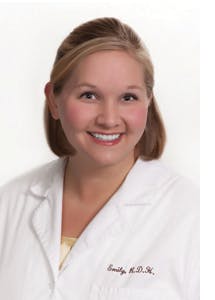Ask Emily: Treating kids, using napkin chains, and paying for your own uniform
By Emily Boge, RDH
August 22, 2013
Dear Emily,
I work at a general practice and right now we are debating about who should see kids, especially during the very busy summer months. Do you see kids in your hygiene schedule? If so, what age do they start with the hygienist and how long do you schedule them in your chair? What do you get accomplished on small children?
-Tia
Dear Tia,
I see all age ranges, and we strive to have all child and adult prophylaxis appointments seen in the hygiene chairs. It is essential for children to see the dental hygienist at a young age because we can take the time to discuss proper homecare techniques and nutritional information with parents, and, ultimately, prevent more problems the sooner we can get them in our chair. I usually see children around age two or three for their first full dental hygiene visit. We generally get 30 minutes with the child and parents. Sometimes the kids do wonderfully and I complete a full pediatric periodontal screening, oral cancer screening, prophylaxis, and fluoride varnish; other times we dance with Al the Alligator and dry tears. The important thing is that the child gets to meet the dental team and see that we might be noisy but we are not scary, and hear a bit about prevention.
Dear Emily,
I am so confused on this whole “napkin chain” fear that is happening in dental offices. Are disposable napkin holders necessary? Is it okay to wipe the napkin chain with a sanitizing wipe or spray the napkin holding chain off after each use? Is it necessary to autoclave the napkin chain? Everyone I ask seems to have a different opinion on the subject – HELP!
-Silvia
Dear Silvia,
I have seen offices tilt to one end of the spectrum or another when discussing disposables. Some offices feel the risk for cross contamination is reduced with each disposable item that can be used. Others want to decrease the office’s carbon footprint by disinfecting as much as possible. There are many factors to consider, including the cost of the item, the cost in time to sterilize each item repeatedly by the dental team, and the overall wear and tear on the item during the process of disinfection (whether the item is sprayed, wiped, heated, or steamed). Despite the convincing advertising for disposable napkin holder use, I still believe napkin holders that can be effectively autoclaved are okay in my book. I have read the studies citing one in five napkin chains harbor micro-organisms, yet I question how many of the napkin holders in the studies were part of a monitored sterilization and disinfection team protocol. Maintaining effective gold-standard team practices assures that each and every item in the operatory is held to the standard of care that assures optimum patient health.
Emily
Dear Emily,
My new employer says that I have to pay for my scrubs, lab jackets, and shoes myself, and I can wear whatever uniform I choose. As a newly licensed hygienist I am curious if this is commonplace in the dental field. Does everyone pay for their own uniforms?
-Brittney
Dear Brittney,
According to the United States Fair Labor Standards Act, if wearing a uniform is required by the employer or to meet standards set forth for occupational safety, the cost and maintenance of uniforms is considered a business expense of an employer, but the employer can deduct the cost from the employee’s salary. That being said, individual states still have the power to pass statutes or laws regarding uniform compensation. My advice to you in the future is to have the uniform discussion during the interview process. If the office has a handbook, it should include a section on uniform reimbursement and laundry expenses. Many offices provide a yearly stipend for uniforms and footwear. Others purchase uniforms once a year, and if additional wear and tear occurs the employee pays out-of-pocket. I would treat uniforms as a negotiated benefit if not listed in the employee handbook. My employer choses a color and we are given a set dollar amount per year for uniforms. In our office, our uniforms are laundered on-site, encouraging us to decrease the possibility of carrying extra germs along home. Consider explaining to your new employer that you did not anticipate the expense of uniforms, and ask if the office would consider purchasing your first set.
Emily
---
Resident hygiene expert Emily Boge answers your toughest questions on professional relationships with instructors, employers, and patients, what to use and know in the clinical setting, and how to successfully make the transition from student to professional. Send your questions to [email protected], and you may see it in next month’s column!
More "Ask Emily" columns:
Ask Emily: Assisting while employed as a hygienist, liability insurance, working interviews
Ask Emily: Dental implants, patient confirmation, and alternative cavity detection
Ask Emily: Nose rings, scheduling from the chair, and working with sensitive patients


